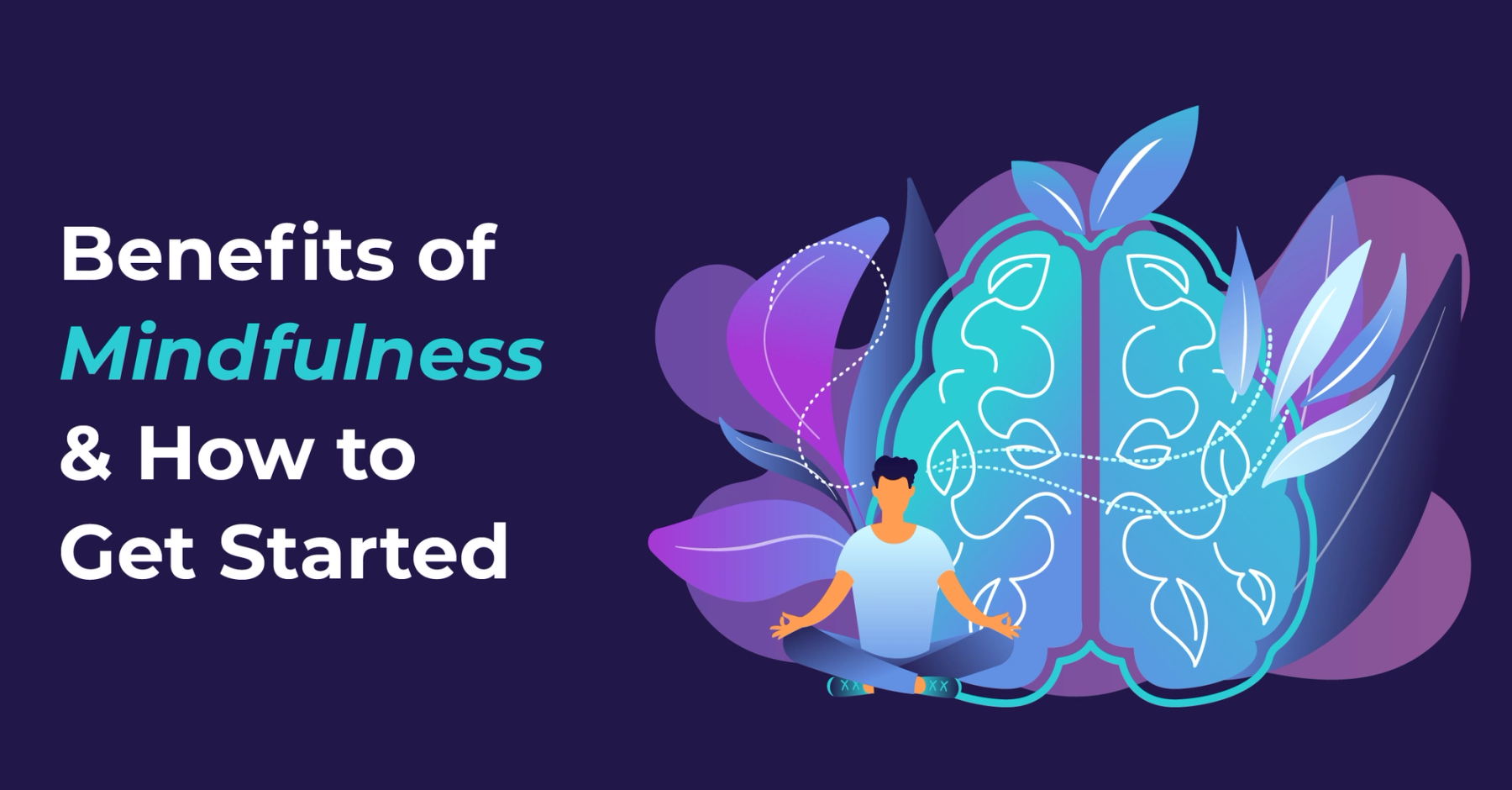Mindfulness is not a new concept, dating back over 2500 years and rooted in Buddhist traditions. This foundation of meditation has become a fast-growing trend in the Western world in recent years. According to the CDC, the practice of meditation has increased threefold in America from 2012 to 2017. Awareness and growth continue today as new studies emerge with evidence of the positive effects of mindfulness on mental and physical health and daily experience.
While many are familiar with the idea of mindfulness, there are common misconceptions about what it means and how it's practiced. I have encountered many people who say they “don’t have time to practice mindfulness,” or “aren’t into meditation.” I've found value in the practice of mindfulness throughout both my work with clients and my personal life. I am excited as research continues to demonstrate positive effects on mental and physical health, stress reduction, and overall well-being.
What is Mindfulness?
While mindfulness practice can include meditation, they are not synonymous. The first element of mindfulness is being present.
Sure, that sounds simple, but in a society where productivity is paramount, many of us find ourselves attempting to multitask. The problem with multitasking is we are never fully present, not really attending to anything we are doing. Simply put, multitasking does not exist. When you attempt to multitask, you aren’t fully present. You aren’t attending to what you would like to, and you are wasting more time switching attention between tasks.
While you may feel less productive shifting from “doing” multiple things at once, over time you will notice an increase in efficiency and likely feel better about the quality of the work you’ve done on any particular task.
The second element of mindfulness is accepting what is happening at the moment without judgment, also referred to as “non-judgmental awareness.” As difficult as it may be for many of us to be present and not think about the past or future from moment to moment, observing without judgment can be a challenge.
This involves avoiding the impulse to label thoughts or situations. For example, if you have a negative thought, instead of saying “that’s a bad thought” or getting down on yourself for having an anxious or depressive thought, simply say “I had a thought that (fill in the blank).” We are noticing things as they occur without getting attached to them, which often happens when we start to assign judgments.
Finally, when one is practicing mindfulness, they are attending to each new moment as it occurs. This can be challenging because many of us are thinking about past events, whether they be far in the past or moments earlier, while others are constantly planning their next move.
Benefits of Mindfulness
So, what are the benefits of practicing mindfulness? Research has shown there are many possible health benefits of practicing daily mindfulness and meditation, including:
- Decreased blood pressure: Studies have shown that practicing mindfulness daily can improve blood pressure and heart rate. Additionally, studies have shown that it lowers the risk of heart disease and stroke.
- Improved immune functioning: studies have shown that by practicing mindfulness we can reduce cortisol levels (stress hormones), which can help boost our immune functioning.
- Managing chronic pain: Studies have shown that consistent mindfulness practice has helped improve the experience of pain for many while reducing pain for others.
- Improved quality of sleep and reduces fatigue: Studies have shown that people who practice mindfulness daily had less trouble falling asleep at night and experienced less fatigue overall. Additionally, practicing mindfulness meditation at night can help you fall asleep faster and improve your quality of sleep over time.
- Stress reduction: Practicing mindfulness has been shown to lower both chronic and acute stress levels by helping people to focus on the present, which decreases rumination and anxiety. Reducing stress plays an important role in improving both your physical and mental health.
Additionally, mindfulness practice has been linked to changes in the brain. Studies have shown that practicing mindfulness has led to changes in gray matter concentration in the brain which can lead to improvements in emotion regulation and memory. Mindfulness practice has been found to decrease the volume of the amygdala, which can lead to decreased experiences of anxiety and stress. These changes in the brain have led to improvements in cognitive functioning including:
- Improved focus: Practicing mindfulness consistently can help improve your focus over time. Studies have shown that people who consistently meditate experience improvements in their ability to focus on various tasks. By meditating we practice focusing on our breath and it helps us improve our focus over time.
- Improvement in working memory: Studies show that practicing mindfulness consistently over time has led to improvements in working memory capacity compared to people who do not practice mindfulness.
- Increased cognitive flexibility: Studies have shown that consistent mindfulness practice has led to improvements in cognitive flexibility (our ability to adapt to changes in our environment). By practicing focusing on the present, we are aware of what is happening at the moment and can adapt in more productive ways.
How Does Mindfulness Help Your Mental Health
Mindfulness has been included in mental health treatment for a wide range of disorders. Research shows that mindfulness practice and programs such as Mindfulness-Based Stress Reduction (MBSR) and Mindfulness-Based Cognitive therapy provide benefits for treating depression, anxiety disorders, substance use disorders, and eating disorders among others.
- Depression: By practicing cognitive therapy combined with mindfulness, we learn to be more aware of negative thoughts as they occur and redirect our attention from them to stay in the present moment.
- Anxiety: Instead of overthinking or avoiding things that make us anxious, mindfulness helps us learn to live in the moment and tolerate anxiety when it occurs.
- Substance use disorders: Mindfulness-based treatment approaches for substance use disorders involve targeting cravings and behaviors related to substance use. By becoming more mindful of these urges when they occur, one can learn to ride them out instead of engaging in those behaviors.
- Eating Disorders: Practicing mindfulness can help increase awareness of thoughts related to food and body weight and shape, as well as helping one to stay present and resist urges to engage in eating disordered behaviors. Learning to eat mindfully is also a helpful tool in eating disorder recovery.
How To Start Practicing Mindfulness
Mindfulness simply means being fully present in each moment, and it can be practiced every day, anywhere, anytime. Practicing mindfulness involves practicing different skills to be present moment to moment.
If you are trying to practice mindfulness and get distracted, that’s okay! Noticing you have gotten distracted and bringing your attention back to the moment is practicing mindfulness! Here are some ways you can start practicing today:
- Deep breathing: You can do this anywhere. Start by focusing on the present moment, sit in a comfortable position (you can also be standing while you do this), and take slow deep breaths in through your nose and out through your mouth.
- Triangle breathing can be a helpful guided way to practice this, you start by breathing in for three seconds, holding your breath for three seconds, and then breathing out for three seconds.
- Meditate: You can do this anywhere as well. It may be more helpful to practice this in a quiet comfortable place. The easiest way to start learning to meditate is by practicing guided meditation. These can range anywhere from 1 minute to 30 minutes or longer. Start with a short guided meditation anywhere from 1 to 10 minutes. Many apps provide guided meditations focused on learning to meditate, deep breathing, managing anxiety, improving self-esteem, and more.
- Insight timer, Headspace, and Calm are all apps that contain guided free meditations and meditation programs you can purchase.
- Grounding exercises: These mindfulness exercises are particularly helpful if you experience moments of high anxiety, panic attacks, or urges to engage in harmful or impulsive behaviors. These exercises help one to come down from a heightened emotional state, back to the present moment.
- The five senses grounding exercise involves engaging with your environment using your five senses. You can do this by identifying five things you can see, four things you can feel, three things you can hear, two things you can smell, and one thing you can taste.
- You can also use your five senses to the ground by engaging in different activities that activate these senses to help you ground. Some examples include smelling comforting scents, using temperature by taking a cold shower or splashing cold water on your face.
- Mindful Eating: Whether you struggle with disordered eating or not, mindful eating is a helpful tool for us all. You can practice it by eating slowly and focusing on the food without distractions. Notice how the food looks, smells, and tastes, and notice the texture of it. Mindful eating is listening to your body, knowing when you are actually physically hungry and when you may be eating for other reasons. Being aware of this is a helpful way to connect with your body and provide it with the nourishment it needs to function in a healthy way.
- Stop, notice your surroundings, and check-in with yourself: Take moments throughout your day to stop, look around you, take deep breaths, and ask yourself how you are feeling in the moment. Notice your thoughts and feelings, as well as noticing what is happening around you will help you learn to be more present moment to moment throughout your day.
References
Brown, K. W., Creswell, J. D., & Ryan, R. M. (Eds.). (2015). Handbook of mindfulness: Theory, research, and practice. The Guilford Press.
Centers for Disease Control and Prevention. (2018, November 8). Use of yoga and meditation becoming more popular in U.S. Centers for Disease Control and Prevention.
Written by: Dr. Nicole Ortiz, PhD
Clarity Clinic
At Clarity Clinic, we have highly trained staff who specialize in therapy and psychiatry services. To learn more about how we can support your mental health, call Clarity Clinic on (312) 815-9660 or schedule an appointment today.
Schedule Now



